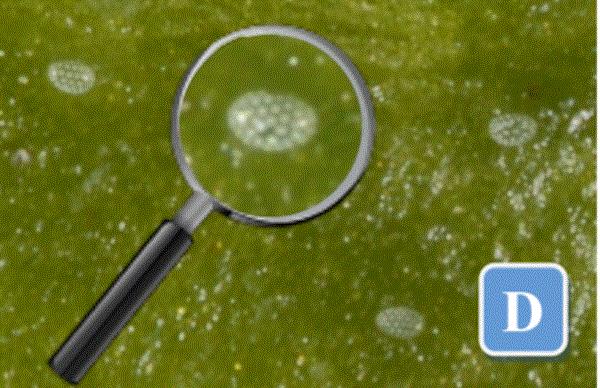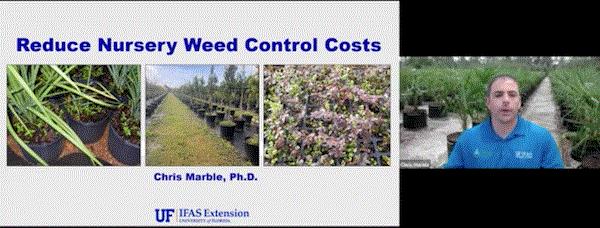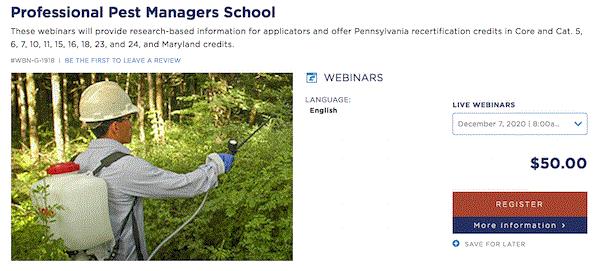|
|

|
Bug people on hemp
Indoor hemp pests
IPM & production videos
PSU IPM webinar |
 |
 |
Bug people talk hemp
The past two weeks had been big weeks for me. More than 3,000 entomologists participated in the annual meeting of the Entomological Society of America. Where else, but virtually? I’m part of the planning committee, so it has been quite an experience to see the entire in-person-to-virtual process unfold.
I stole a few moments from tending to my regular job duties and committee responsibilities to attend a few interesting symposia. (I guess that’s the problem with a virtual meeting—you can't use attending an out-of-town meeting as an excuse to get away from the daily tasks in the office.)
One of them is on hemp, where speakers from Canada and the United States shared their experience and challenges in managing insects and mites on this relatively new crop. The major pests my colleagues have observed in hemp fields are:
-
Alabama (Katelyn Kesheimer, Auburn University): Katelyn’s presentation focused on the red imported fire ant. In this case, it’s not that the fire ants are stinging workers or causing any other medical issue. (If y’all are curious what fire ants can do to you, sign up for my Fire-on-Your-You-Know-What Tour. Taking reservations for 2022 tours right now; 2021 tours are sold out.) Fire ants will actually hallow out or girdle the stems, eventually killing the plants. I’ve seen this problem first-hand. Based on Katelyn’s data, I didn’t detect consistent suppression when the fields are treated with soil fumigant (chloropicrin + 1,3-dichloropropene) and/or bait (methoprene).

Red imported fire ants girdled a hemp stem. (Photo credit: Allison Justice, The Hemp MIne.)
-
California (Houston Wilson, University of California—Riverside): Based on a survey of growers, the key pests of cannabis in California are hemp russet mite and spider mite, followed by thrips, unknown larvae (I assume caterpillars), aphids (including root aphids), broad mite, other mite species, grasshopper, cucumber beetle, whitefly, leafhopper, and fungus gnat. The major diseases are powdery mildew, followed by mold, rot and other diseases. Gophers, mice and rats are the major vertebrate pests, followed by deer, boars and other.
-
Canada (Jonathan Cale, Canopy Growth Corporation): About 490 acres of indoor production and 1,340 acres of outdoor production. Major pests are aphids (cannabis and rice root), mites, thrips and stem borers, which cause more than $5 million worth of damage annually.
-
Colorado (Whitney Cranshaw, Colorado State University): Whitney focused on hemp russet mite. Sulfur is the most effective product, with two applications performing better than one in increasing yield. Suffoil-X provides good efficacy; and neem oil (Trilogy), soybean oil + sodium lauryl sulfate (Green Cleaner), rosemary oil + peppermint oil (Ecotrol) and rosemary oil (TetraCurb) provide fair control. Pyrethrins, insecticidal soap and azadirachtin have poor efficacy. Commercially available predatory mites didn't seem particularly effective.
-
New Mexico (Amanda Skidmore, New Mexico State University): There are about 800 acres in production in 2020. Water resource for irrigation, naturally, is a major production challenge in New Mexico.
-
Oregon (Silvia Rondon, Oregon State University): Major pests are wireworm, aphids, corn earworm, stalk borer and lygus bug. Silvia is currently working on developing a surveying method by drone for damage caused by wireworm and virus transmitted by leafhoppers.
-
Tennessee (Jerome Grant and Julian Cosner, University of Tennessee): Licensed acreage has dropped from the high of 51,000 in 2019 to 15,879 acres in 2020, with about 777 acres of indoor production. A survey of growers in 2018 reported mite, thrips, caterpillar (including yellowstriped armyworm and woollybear caterpillar), flea beetle, fungus gnat, stink bug, aphid, grasshopper, Japanese beetle, cucumber beetle and whitefly as pests. Caterpillars, particularly the corn earworm, are the major pests.
-
Virginia (Kadie Britt, Virginia Tech): There are lots of bugs that chew on the leaves, such as Japanese beetle, grasshopper, leaf beetle, weevil and caterpillar. Other pests, such as aphid, stink bug, leafhopper, spider mite, hemp russet mite, termite, fire ant, wireworm and fungus gnat get on different parts of a plant. Many of these are opportunistic pests and may not be damaging. But the leaf feeders, such as leaf beetles and caterpillars, can be an issue. Field insecticide efficacy trials suggested that nucleopolyhedrovirus was more effective than Bt and pyrethrins in reducing corn earworm numbers.
 Hemp pests indoors
The symposium focused on pests of hemp grown outdoors. In my experience, pest spectrum and importance are different between indoor and outdoor production. For example, caterpillars are the major pests of outdoor production. In indoor growing facilities, however, caterpillars are only an occasional issue.
So what are the major indoor hemp pests?
Based on what I’ve seen or am contacted for, mites are by far the most common pests. Twospotted spider mite is probably the most frequently asked, followed by hemp russet mite. I’m starting to hear more about broad mite. Stippling and silvering of foliage by spider mites are pretty easy to identify. Hemp russet mite causes (what I call) graying and curling of leaves. Broad mite causes terminal growth distortion.
There are two sources of mites—existing population on volunteer and other plants, and introduction via liners. Clean up any plant other than your cannabis crop in the greenhouse. Also, start your management program when the plants are still in propagation. Horticultural oil is my choice for managing mites. But remember to achieve thorough spray coverage and don't use sulfur if you are using horticultural oil (and vise versa).
As observed by Whitney Cranshaw, few macro-biological control agents work well against hemp russet mite. You could use Neoseiulus californicus or Phytoseiulus persimilis against spider mites, and Amblyseius swirskii or Neoseiulus cucumeris against broad mites. Understand, however, predatory mites are most useful in early growth. They may not be as effective once sticky trichomes appear.

Broad mite infestation can be identified by looking for the eggs, which look like "footballs." (Photo from Nicole Casuso and Hugh Smith, 2017, University of Florida.)
And we have the aphids—cannabis aphid and rice root aphid attracting the most attention. You should also keep an eye on aphid species that have a broad host range, such as melon aphid. I have read that green peach aphid, black bean aphid and hop aphid can get onto cannabis, but I haven't seen these species.
Finding and treating the aphid population early is the key to success. Aphids you find on the canopy are not super-difficult to control; horticultural oil and insecticidal soap often work well. Root aphids, on the other hand, are very tricky. Drenching with entomopathogenic fungi (Beauveria bassiana, Isaria fumosorosea and Metarhizium anisopliae) is one option, but folks have reported inconsistent efficacy. A lot of research is needed on the biology and management of the rice root aphid.
I’ve been contacted about fungus gnat infestations. You know what? All these cases were the results of wet propagation medium. So keep the medium on the dry side, y’all. That’s the sure-fire way to keep fungus gnats out.
Although thrips and whiteflies are major pests in greenhouse ornamental production, they’re only minor irritations in cannabis production. I also have very few reports of caterpillar infestations in greenhouses. A low number of reports doesn't mean they won't become a problem though—keep an eye out to find and treat the population early.
I know I’ve been yakking about hemp for most of this issue, but I ask you to indulge me. You see, bugs on ornamental plants, turfgrass and (more recently) vegetables are my bread-and-butter, but hemp is such a new crop that there is so much still to learn about this system. Like a puppy given a new chew toy, I’m just excited about new pests and management challenges!  IPM and nursery production videos
The University of Florida Greenhouse Training Online Course, with support from the Floriculture Research Alliance, recently posted a series of videos on “Five Tips" to various pest management and production practices on its YouTube channel.
These are eight- to 19-minute videos covering various topics and presented by leading researchers and experts in the field. There are six videos covering weed management (Chris Marble), testing irrigation water chemistry (Paul Fisher), water quality impacts on pesticides (Sarah White), monitoring hydroponic systems (Jon Greene), hydropinic substrates (Shawn Mallen) and vermicompost (by Dan Jacques) at this time, but more will be coming.

I’m not going to give away the contents of the presentation, so check out the videos for yourself by clicking here. Also check out the other "Nursery Best Management Practices" videos while you are there. PSU IPM training webinar
Penn State Extension will host a one-day pest management webinar on December 7, starting at 8:30 a.m. This is an opportunity for pesticide applicators to earn Pennsylvania and Maryland recertification credits in multiple categories. Cost of registration is $50. Deadline for registration is December 6.

Participants of the Professional Pest Managers School can choose among five concurrent sessions, so that they can get training most suited for their licenses and operations. Instructors will talk about pest and weed identification; Spotted Lanternfly control; cockroach, mice and mosquito management; conifer insects; stinging insects; pollinator protection; pest management in turf; herbicide selection and rotation; formulations and adjuvants; spill management; winterization of pool surfaces; health effects of pesticides; and many more.
Click here to register for the webinar.
Have a wonderful and safe Thanksgiving holiday!

JC Chong
Professor of Entomology at Clemson University
This e-mail received by 23,489 subscribers like you!
If you're interested in advertising on PestTalks contact Kim Brown ASAP!
|